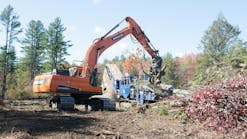Imagine climbing into the seat of a rental car and finding the steering column or gear shifter in a different location. Although confused at first, you would eventually become familiar with the controls—and may even learn to love the new setup.
With the advent of mass vehicle production, the automobile industry standardized its controls more than a century ago. Construction equipment manufacturers see controls differently, and their nuanced approach to control technology is often viewed as a competitive edge and a way to offer variety in the marketplace.
Today, motor grader operators may find a conventional steering wheel and levers or electric-over-hydraulic joystick controls in the cab, depending on the make and model of the machine. Many operators have a preference on the style and as new controls hit the marketplace, operators may need to be convinced that the new controls are smoother, more precise, and prevent fatigue.
At CONEXPO-CON/AGG, a major construction equipment manufacturer rolled out a grader with all-new controls, and it saw the show as a perfect opportunity for potential buyers and users to experience the controls and provide feedback on the system. The OEM partnered with CM Labs Simulations Inc. to produce a motor grader simulator to help articulate its vision to its customers. Out of this partnership, CM Labs’ new motor grader simulator training package was born.
Working with seasoned operators to provide feedback on the visual aspect of the simulator and the functionality of the controls, CM Labs was able to develop its Vortex motor grader simulator with real-world viewpoints. “They tell us when something doesn’t feel right or we need to make the controls more responsive,” says Drew Carruthers, CM Labs’ product line manager for construction simulation. “So far, we’ve been successful in making those guys happy.”
The feel of the machine is how CM Labs sets itself apart from other earthmoving simulator developers. “The way that the blade interacts with the soil, such as when you take too much of a cut, it will go into stall protection,” he says. “The cross-slope functionality or the saddle locking bar are all things operators will see on real equipment and experience every single day. We are able to replicate it.”
Realism Matters
Typical owners of simulators are training schools, local operating unions, and contractors. CM Labs is conscious that there are still a lot of early adopters and their experiences with a simulator are often their first. “Realism matters a lot because they are forming an opinion on the simulator industry,” says Carruthers. “We need those early adopters or first-time users to say, ‘Yes, this feels like real equipment.’”
A realistic simulator will also teach an operator respect for the machine. “Above everything else, the grader is a very expensive, complex piece of equipment,” says Carruthers. The simulator not only provides new operators with an experience without the fear that they are going to be hurt or damage the machine, but also an understanding that in 15 minutes, they won’t be a motor grader expert. “We want them end up with a level of respect for what they actually experience,” he adds. “Once you get that emotional connection, then they start to build confidence and understand that their actions have consequences.”
From the comfort of a classroom, operators can experience situations that aren’t easy to reproduce. For example, a technique that operators learn in the forestry industry is when they are on logging roads in the forest, they will use the blade like a kayak paddle to propel the machine out of the mud. “How do you train for that?” asks Carruthers. “We allow these operators to get into situations that aren’t easily reproduced and are weather sensitive, so they can prepare.”
Construction schools also will be able to draw in talent that they wouldn’t have been able to access previously. “We’ve heard stories of soldiers coming back and training on simulators to step into their second phase in life,” he says. “They may not have had the confidence to climb into a tower crane or an excavator. Simulators boost their confidence and broaden your workforce.”
Training for Competency
In addition to providing a realistic operating experience, the motor grader simulator training must first ensure the operator is developing safe habits—for instance, any contact with a person during a training exercise would be a critical safety violation—and then also evaluate an operator’s competency with the controls and its proficiency of the operation.
With the first couple of scenarios, the operator should be able to prove efficiency of movement in a certain time. For example, the simulator may require the operator to put the grader’s blade into a certain position. “How long does it take you to get there?” asks Carruthers. “Maybe it takes a half hour the first time, and the second time it takes 15 minutes.”
Then the simulator looks at the operator’s efficiency. “How much material are you moving per gallon of fuel that you are consuming?” he asks. “They need to do it and do it really well.”
Proficiency is also taken into account. “If you’re leveling an area or spreading out materials evenly after its been dumped by a truck, we’ll see that you’re completing the job to a high quality,” he says. “We measure the difference between the highest point and the lowest point and how smooth the surface is. Everyone can complete that to a degree, but how good is the quality? We have a visualization on the screen that indicates how smooth the surface is when you’re done.” He adds that it’s an immediate visceral feedback to show you’ve done a good job or where you need to improve.
For operators who train on a simulator, CM Labs has found they have better understanding of the working technique, but also have respect for the machine. “When you’re in a training school and trying to pile in your eight students into the cab to show them what is happening, there is less of an interaction,” says Carruthers. “When you have a one-on-one experience with a simulator and an instructor in the room, there is much a shorter feedback loop to correct bad behaviors.”
From a timing perspective, Carruthers says training schools with six-week programs are gaining one week of time by working with simulators over traditional operator training programs. “That is one more week to give weaker students more time, or more skilled students can advance further than before and gain more practical experience,” he says. “You’re able to process more students on virtual equipment.”
Simulator Capabilities
For a training facility, operating union, or contractor that is planning to adopt a motor grader simulator, Carruthers suggested putting an experienced operator through the software paces. “The very first thing you need to do is get in the seat and get a feel for it,” he says. “Make sure that you appreciate this is a training took that will expose the strengths and weaknesses of your students.”
He then recommends thinking about how the organization will use it. Do you want to weed out bad operators, promote the industry, or take a jack-of-all-trades and have them specialize on a specific machine?
“What I would ask of people looking at simulators is to expect more,” says Carruthers. “They should expect that simulation has advanced much further than when they heard about it before.” On the motor grader simulator, its more than the cross-slope control and saddle locking bar. “We simulate the hydraulics, the engine, and the stall projection,” he adds. “The tires can get stuck in the mud, and the eight gears forward and eight gears reverse all have top speed. There’s no excuse for the machine to not feel correct.”
At ConExpo, as the OEM demonstrated the new controls on the grader, Carruthers says people were starting to be convinced. “They liked the old controls and they were pretty faithful to them,” he says. “But what we experienced and observed is the old school operators saying: ‘I get it. I understand why you’ve gone with these controls.’” He notes that the OEM sold real equipment at the event based on their experiences on the simulator.
“Simulator buyers should expect that the machine’s ability matches the feel of the equipment,” he says. “There should be no compromise, because otherwise you’re not transferring skills. Otherwise, it’s just a video game.”



